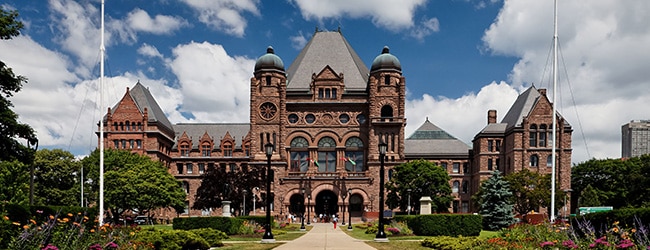Defending Green Development Standards in Ontario
CAGBC Staff on December 6, 2022
- Theme
- Advocacy
- Green Building

In November, CAGBC and many members lent their voice to The Atmospheric Fund’s letter to the Government of Ontario suggesting amendments to Bill 23 – The Building More Homes Faster Act. While everyone supports the development of more housing – especially affordable housing – the letter expressed concerns that Bill-23 could negatively impact municipal green development standards. Addressed to Ontario Premier Doug Ford and sent to the Ministers of Municipal Affairs and Housing, Energy, and Environment, Conservation and Parks, it reads, in part:
“We are concerned about the Act’s impacts on municipal green development standards. Specifically, it appears that this legislation includes clauses that will inadvertently make future homes more unaffordable and less efficient for Ontarians. These clauses in the legislation narrow site planning authorities to an extent that they will prevent municipalities from addressing energy efficiency and climate change in new buildings. This legislation as written would override council-approved sustainable design standards in Toronto, Ottawa, Brampton, Ajax, Whitby, Pickering, Markham, and other municipalities across Ontario. They risk causing disorder in the development process as municipalities with green development standards would have to redesign existing processes, creating uncertainty for both development departments and developers across Ontario. Ultimately, excluding energy, sustainability, and climate from consideration in the planning process will leave new housing exposed to spiralling energy costs and carbon prices.”
Leaders in the building sector also stepped forward to voice their concerns including architects, engineers, and municipalities. Among their criticisms were that the Bill would reduce the supply of affordable housing, encourage urban sprawl, undermine democracy by weakening local government and opportunities for public consultation, remove environmental protections, negatively impact city budgets, and erode sustainable and resilient development practices. In addition, the Association of Municipalities of Ontario indicated costs for Ontario’s 29 largest municipalities could be as much as $5.1-billion over the next nine years in lost development charges.
As a result, the Ontario government tabled several changes to the Bill, stepping back limits on public consultation and enabling some local control over green development standards. However, some of these changes fall short of the calls from stakeholders. Ontario’s Big City Mayors group from cities with 100,000+ residents are planning to meet to discuss the bill and its impact. Public consultation on the controversial Bill has been extended until December 9, and it is important that municipalities and stakeholders continue to push for protection of green development standards.
Some of the provisions in the bill that detract from green development standards are predicated on the misconception that building green is somehow more complicated or cost and time intensive.
Yet, on average, zero carbon buildings can be achieved with a positive financial return of one percent over a 25-year life-cycle, inclusive of carbon pollution pricing, and require a modest eight percent capital cost premium. As the cost of carbon rises, the business case for zero carbon buildings will only grow.
Thinking green now will help building owners avoid costly and disruptive retrofits down the line, which might result in adverse economic impacts such as lost rent, reduced service life, reduced resilience, and diminished asset value. CAGBC supports the building sector by providing voluntary standards such as the LEED rating system and the Zero Carbon Building standards to guide projects to greater sustainability. CAGBC’s Disclosure Challenge helped make the argument for green building by supporting building data disclosure and labelling. Today, we are also supporting Canada’s green building supply chain through our Materials Accelerator.
Given the population of Ontario grows an estimated 193,000 per year, there is no doubt the province is in dire need of new housing. However, the province will miss out on the many co-benefits to be gained from green development practices.
Pursuit of greener, low-carbon and resilient buildings spurs innovation and economic growth. In CAGBC’s 2020 market impact report, we showed how investment in green buildings and progressive policies could, by 2030, grow Ontario’s green building sector to 626,080 direct jobs and contribute $60.8 billion to its GDP. That’s up from 228,000 jobs and $22.7 billion in 2018.
Weakening local advancements in green development standards might speed up development, but it will also make home ownership more expensive for the average Ontarian, erode green spaces, slow emissions reductions, and ultimately put more strain on healthcare and social support systems.
While building new houses with speed is needed, as a sector we can’t let it overshadow sustainability gains. The building sector should continue to support green development locally, or through voluntary standards such as LEED and Zero Carbon Building. Our path to the decarbonization of Canada’s built environment will happen one building at a time – and the sector’s ongoing support and commitment is critical.